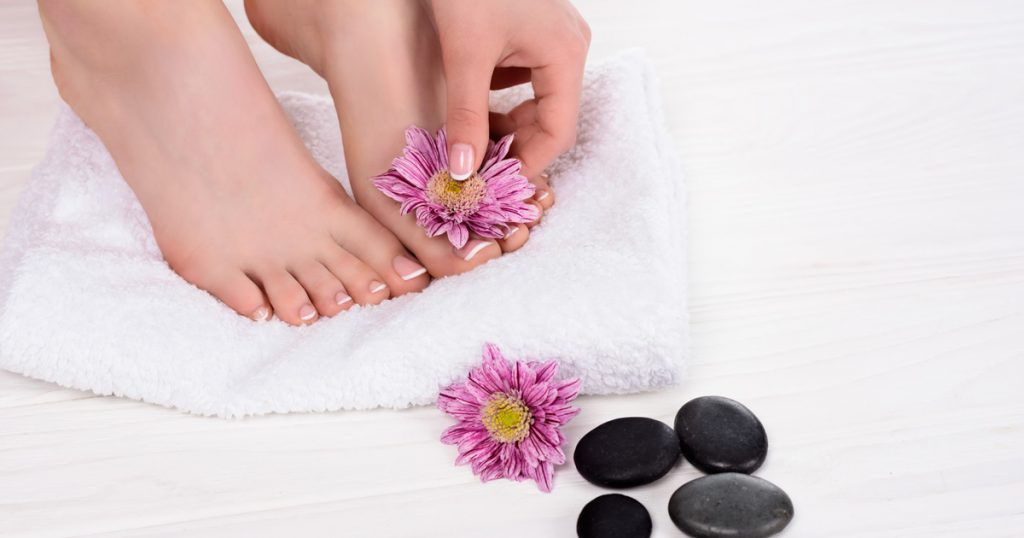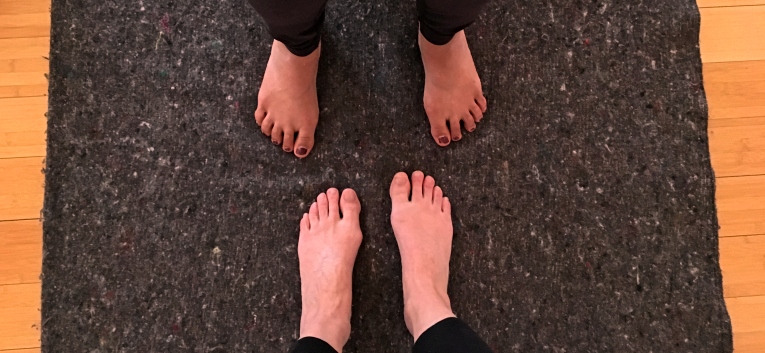
Our feet are of utmost importance to the well-being of our physical body. They support our hips and upper body; they hold us all day long and take us wherever we need to go. Our feet connect us to the earth, giving us a sense of grounding and belonging; they are the roots of our body and our best friends.
How do we take care of our feet? Do we use comfortable shoes? Do we massage them? Do we strengthen them so they keep doing the work they do all day? How can we best support our best friends?
We can support them by paying some loving attention. We can help them keep their health and integrity with some very basic postures and movements.
Some Factors that Affect our Feet:
Aging: our bones and muscles deteriorate with aging.
Weight: Being overweight places too much pressure on the feet joint and ankles.
Lack of proper movement and awareness of how we stand, walk, etc. can increase our chances of having foot problems.
Wearing uncomfortable shoes: With every step we take, our feet are subjected to stress and pressure. Wearing uncomfortable shoes can lead our feet to develop or exacerbate bunions, joint pain, calluses, ingrown toe nails, heel pain, and blisters, among others.
Aging, body structure and our genealogy are unavoidable, but some things can be preventable. When we become mindful of our bodies, we can age with more ease and grace and, hopefully, less physical pain.
A few Common Problems:
- Fallen arches (also called flat feet) Pronated or Supinated feet.
Pronation refers to the inward roll of the foot during normal motion. The inner ankle rolls inward, the outer ankle rolls outward. The outer edge of the heel collapses to the ground causing the foot to roll inward and to flatten out.
Supination is the opposite of pronation and refers to the outward roll of the foot during normal motion. It becomes a problem when it is excessive. The outer ankle rolls inward, the inner ankle outward. This places a large strain on the muscles and tendons that stabilize the ankle and can lead to ankle sprain or total ligament rupture (Fig. 1). - Calluses: Thickened skin from friction or pressure.
- Bunions: Hard, painful bumps on the big joint.
- Plantar warts: Warts on the soles of your feet.
- Crunched toes: This can happen due to uncomfortable shoes (wrong size, too tight in some places, or wearing high heels)
Fig. 1
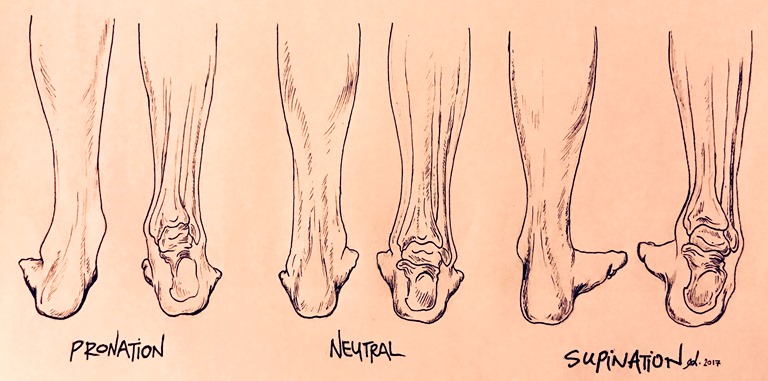
Each of your feet has 26 bones, 33 joints, and more than 100 tendons, muscles, and ligaments. How do we take care of this complex structure?
Strengthening your feet will make a difference. You will begin to understand how the feet impact the rest of your body. The way you stand, with feet externally rotated (toes out) or internally rotated (toes in), pronated (the weight on the outer edges of your feet), or supinated (weight on the inner edges), will impact your knees. Your knees will impact the hips. The hips will impact the spine, and so on. These are the reasons why you should look at your feet as your main foundation. The feet govern your legs the entire time that we stand; in turn, your legs govern your spine. Hence, the importance of knowing, understanding and being aware of and connected to your foundation.
One of the best ways to strengthen the feet is through a Yogasana practice. Asanas (physical postures) bring constant awareness to your foundation. In standing poses, the foundation is the feet. Paying attention to how you stand and how you can activate the muscles of the feet to cultivate strength in arches and ankles will prevent all kinds of structural problems. The Asanas activate and open all bones and joints in the feet and elongate and expand the muscles. Your feet, being so connected to the earth, make your foundation stronger and help heal issues of inflammation, tightness, rigidity, while helping you connect to a deep sense of balance and inner strength.
A good way to see your tendencies is to stand up the way you normally do and notice your habits. Notice if the feet are internally or externally rotated, if you tend to put weight in the front or the back of the feet, or if you tend to put weight in the outer or the inner edges of our feet. The wear of the soles of your shoes can also tell you much about the way you stand, walk, etc. Is the inside or the outside of your heel worn down? If there is excessive wear on one side, it’s very likely that your entire body is suffering the consequences of this imbalance. Whatever your tendencies, they either may help your body or may contribute to your knee, hips, spine, and neck issues.
The Importance of Mountain Pose – A Practice that Starts at the Feet
Mountain Pose, or Tadasana (Fig. 2): Mountain pose in yoga is considered the blueprint pose because its position of neutrality teaches us how to stand upright and how to align bones and engage muscles. Every other yoga pose has an element of Mountain pose. We always start from our foundation, which is this case is our feet. It teaches us how to expand the soles and relax the toes so that we create integrity from the bottom up. Mountain Pose teaches us how to find the points of pressure and points of relaxation in the feet, how to keep and cultivate the inner and outer arches, how to keep the inner and outer ankles engaged and strong, and how to expand and hold our bodies so that our entire body finds integrity.
Fig. 2
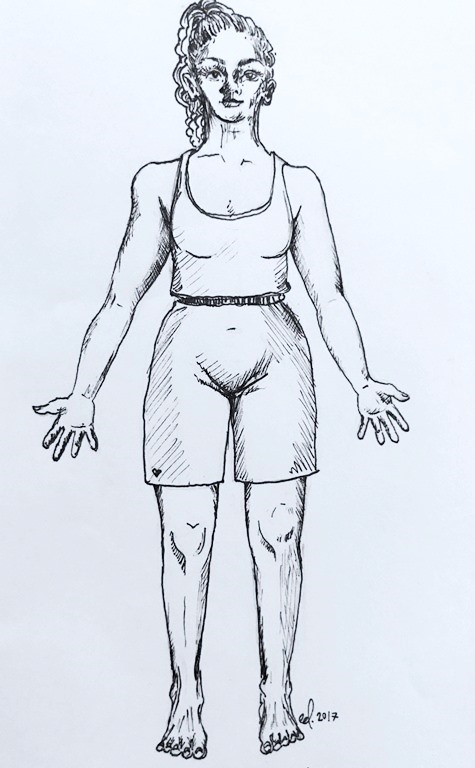
Mountain Pose
1- Finding the Four Points of Your feet
Start by finding the four corners of each foot: Base of the big toe, base of the little toe, and the inner and outer heel. To find those points, gently lift your toes. This action will help you find those four points and will make you more aware of your body and your foundation. Press these four points into the earth and spread and relax your toes. Keep breathing, making sure you are not holding tension in your jaw or gaze. Your foundation will help you start cultivating awareness and strength in the rest of your body and you will begin to distribute the weight equally on both feet and legs. As you go through your day, see if you can stay connected to those four points of your feet as you stand, walk, and even run.
2 -Finding Expansion Through your Feet
Find the foundation of your feet: lift your toes, spread and then release them as a way to expand and widen the soles of your feet. These actions will start working on the articulation, strength and flexibility of your toes. If you have a block, place the block between your thighs and gently squeeze it to activate inner thighs. As you activate the medial arches, notice the elongation and energetic alignment of your inner thighs, which will rotate gently towards the back body as you squeeze your block. This will translate into the activation of your little belly (pubic bone to navel) and will allow you to release the tail bone, without over tucking it. Feel the outer arches and the elongation and energetic action that rebounds and helps you firm and activate the outer hips; lift your chest and reach up through the crown of your head to feel the elongation of the spine. Feel the back body broadening as you relax your frontal ribs. Again, notice if these actions are creating tension in some parts of your body, like your jaw or your gaze. Focus on your inner body connection with the outer body; breathe and relax in Mountain Pose.
3 – Deepening your Awareness
As you keep moving through your foundation you are becoming aware of the actions of your lower body, helping correct the alignment of your knees, hips and back.
What is tailbone elongation?: It’s the activation of the back body in connection with the front body. We are not over-tucking or pushing pelvis forward. It is the release of the buttock flesh away from your lower back. This action keeps the integrity of your lower back and therefore the rest of your spine and back body. It also helps you keep your lower belly active.
As you release the tailbone, reach up through the crown of your head (lengthen throughout your entire spine). Lift your chest but contain your frontal ribs (no pushing the front ribs forward). Keep the spine neutral and connect to the back body. Notice the side body. From the outer arches of your feet, you’re creating length throughout the side body, feeling the armpits lifting and expanding. Your shoulders are completely relaxed. Your chin remains parallel to the floor so your neck remains long. Your neck is an extension of your spine; keep it neutral and long at all four sides. Learning how to cultivate the strength and well-being of your feet is actually the first step towards knowing how to practice Mountain pose.
Mountain Pose will help you cultivate a multi-dimensional awareness of your entire body.
Dynamic Movement: Strengthens the Balls of the Feet, Inner/Outer Arches, Ankles and Calf muscles.
Stand in Mountain Pose.
As you inhale, slowly lift the right heel, bending your knee, (you can also start with the left). Feel the ball of the foot gently pressing down, the toes expanding, the arches and the top of the feet stretching, and the ankles flexing (Fig. 3).
Fig. 3
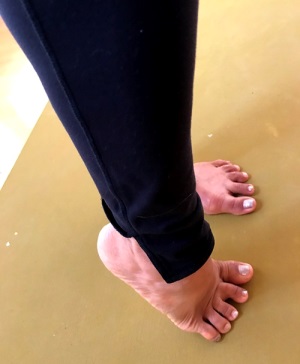
Release slowly with your exhalation. Keep your toes expanding and feeling the space between each toe. Notice the sole of the foot releasing and stretching as you connect to the earth. Keep the integrity of the inner arches as best you can by lifting your toes (you will see the inner arches of your feet); then, release the toes and keep them relaxed.
Proceed with the other foot, using your inhales and exhales (Fig. 4)
Fig. 4
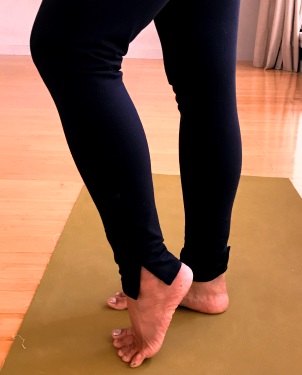
REPEAT as many times as you can. Doing this exercise about 10 to 15 minutes each day may be enough for some people.
Next, try lifting both heels together (Fig. 5). Repeat several times and then hold the pose for some time. Maintain Mountain pose in the rest of your body, keeping your spine neutral, tailbone releasing, and your belly engaged. (A chair may be used for support). Fifteen to 20 minutes of this work will give your feet and ankles a good stretch.
Fig. 5
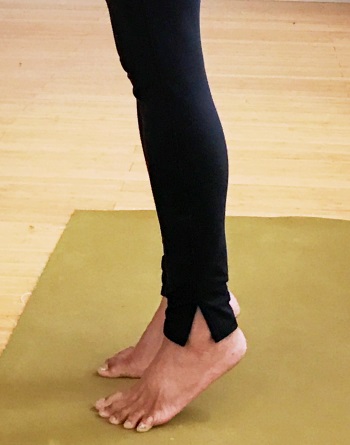
Finally, relaxation and a holistic approach to our well-being will help us feel better about our body and life. Our physical body may hold tension, anxiety, trauma, emotional and physical pain. This physical tension may translate into being overweight, tight, stressed, depressed, etc. This may contribute to a rounded back, over tucked tailbone, and so forth, which will bring our entire body out of balance.
Finding a good yoga teacher, a healer, or a holistic practitioner to talk to and practice with, can help bring some ease to our minds and bodies. Good practices can help us bring our inner and outer body to a place of harmony and strength. We must also remember that the road to well-being may be a life-long journey and it requires commitment and discipline and a willingness to face our fears and pains. It also requires a willingness to let go and surrender so that we find complete self-acceptance and our beautiful true selves.
Drawings by Esther Dane. Contact: dane.esther@gmail.com

